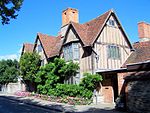The Shakespeare funerary monument is a memorial to William Shakespeare located inside Holy Trinity Church at Stratford-upon-Avon in Warwickshire, the church in which Shakespeare was baptised and where he was buried in the chancel two days after his death.The monument, carved in pale blue limestone, is mounted on the north wall of the chancel. It has traditionally been identified as the work of the sculptor Gerard Johnson, but this attribution is challenged by Lena Cowen Orlin, who argues that it was more likely modelled from life by Gerard's brother, Nicholas Johnson. The monument features a demi-figure of the poet holding a (real) quill pen in one hand and a piece of paper resting on a cushion in the other. The style, which was popular from the early- to the mid-17th century, was most commonly used to memorialize divines, academics, and those professions with pretensions of learning. The buttoned doublet, with its ornamental slashes, was probably originally painted scarlet, the loose subfusc gown black, the eyes hazel, and the hair and beard auburn. It has been retouched many times, and was painted entirely white in 1793. This demi-figure is one of only two representations definitely accepted as accurately portraying William Shakespeare's physical appearance. The monument is topped with strapwork rising to a heraldic shield displaying Shakespeare's arms, on either side of which sits an allegorical figure: one, representing Labour, holds a spade, the other, representing Rest, holds an inverted torch and a skull.The two columns that support the entablatures and coat-of-arms above the bust are of black polished marble. The two putti and the skull are of sandstone, and the capitals and bases of the columns are of gilded sandstone. The architraves, frieze and cornice were originally of red-veined white alabaster, but they were replaced in 1749 with white marble. The effigy and the cushion are carved of one piece of bluish Cotswold limestone, and the inlaid panels are of black touchstone.The date the monument was erected is not known exactly, but it must have been before 1623; in that year, the First Folio of Shakespeare's works was published, prefaced by a poem by Leonard Digges that mentions "thy Stratford moniment" [sic]. John Weever transcribed the monument inscription and grave epitaph, and H. R. Woudhuysen's analysis of the undated manuscript suggests that his visit to Stratford was made not much later than 1617–18. The monument was restored in 1748–49 and has been repainted several times.










